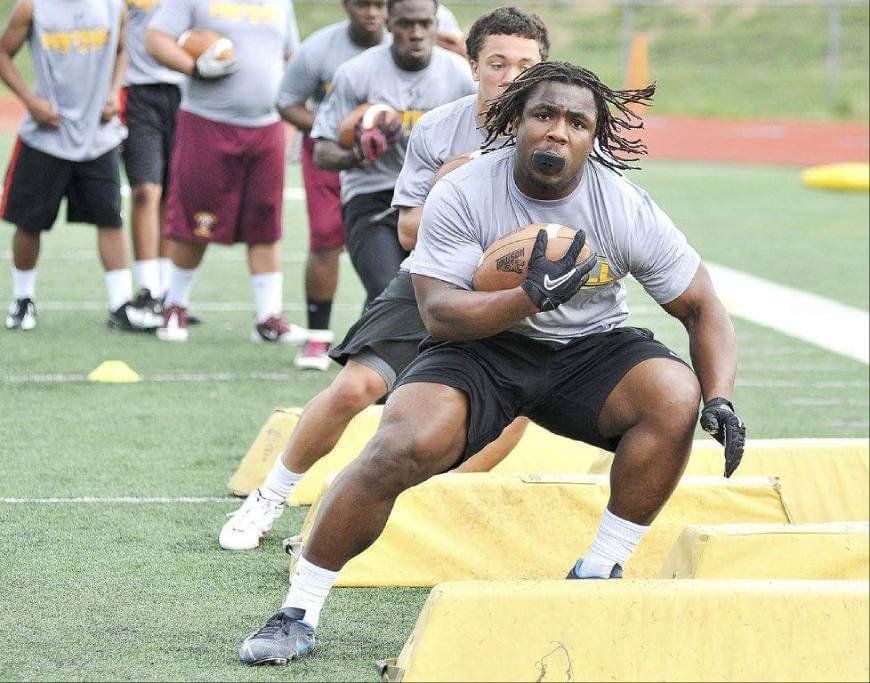If you’re getting injured, you’re not on the field. If you’re not on the field playing, you’re not getting better. If you’re not getting better, Nick Saban and Bo Pelini aren’t sending you letters asking you to have dinner with them and their family, their football family that is. Make sure your doing everything you can to prevent those football injuries. They can happen after a huge hit or from making a cut. Although either one can knock you out of the game or season, non-contact injuries are some of the most frustrating injuries. These occur due to poor mechanics or weakness in a muscle group that stabilizes a joint. We’ll touch on a couple ways to help prevent these injuries from happening.
Preventing Knee Injuries
Take a look at a running back taking a cut as he’s changing direction. Is he using his outside or inside leg to push off with? In most cases its his outside leg that he’s using to make the initial cut with. If its the inside leg, chances are he’s not running anymore. Many non-contact knee injuries occur this was as the knee is put under more force and torque than it could handle when its under the body.
As you go through drills, focus on pushing with your outside leg. This puts your knee in its strongest and most powerful position, protecting it from possible ligament damage.
 There are several prehab exercises that will help prevent injury by activating the muscles that support the knee. One exercise is the terminal knee extension (TKE), which targets the vastus medialis oblique (VMO). Other exercises such as a single leg hop and hold the landing will help target the quadriceps and increase stabilization. While performing any of the knee exercises, keep your knee tracking in the direction of your foot and don’t allow it to fall inward or outward. This facilitates proper mechanics trains the muscles to perform this movement when needed most, in the game.
There are several prehab exercises that will help prevent injury by activating the muscles that support the knee. One exercise is the terminal knee extension (TKE), which targets the vastus medialis oblique (VMO). Other exercises such as a single leg hop and hold the landing will help target the quadriceps and increase stabilization. While performing any of the knee exercises, keep your knee tracking in the direction of your foot and don’t allow it to fall inward or outward. This facilitates proper mechanics trains the muscles to perform this movement when needed most, in the game.
Injuries that occur from contact are hard to prevent from the prehab exercises above but the severity of the injury can be decreased.
What Supports the Knee
The ligaments that support the knee include two (medial and lateral) collateral ligaments and two (anterior and posterior) cruciate ligaments. The medial and lateral collateral ligaments prevent the knee from buckling inward and outwards and is often injured from being hit from the outside of the knee. As for the anterior and posterior cruciate ligaments, they prevent rotation and front to back movement of the tibia under the femur and are located with in the joint.
The knee joint moves over two menisci that act as a cushion for your upper leg (or femur) on top of the shin (tibia). Injuries and complications to the meniscus often occur with rotation of the tibia under the femur as with ACL and PCL injuries and often at the same time. Some symptoms might include the feeling of instability, swelling and stiffness.
Decreasing Recovery Time
Recovery from injuries to these ligaments often take 6-12 months. Going through physical therapy prior to surgery greatly decreases the length of therapy after surgery. It increases range of motion and prepares your quad for post-surgery strengthening. Through out the process, rest, ice, and elevation will help decrease the swelling that will also help decrease the recovery time, getting you back to the playing field faster.
Don’t assume the time you put in at physical therapy is all you need. Be sure to follow the home exercise program your physical therapist has prescribed to stay on track.
For more blog updates “Like” us on Facebook and follow us one Twitter.
